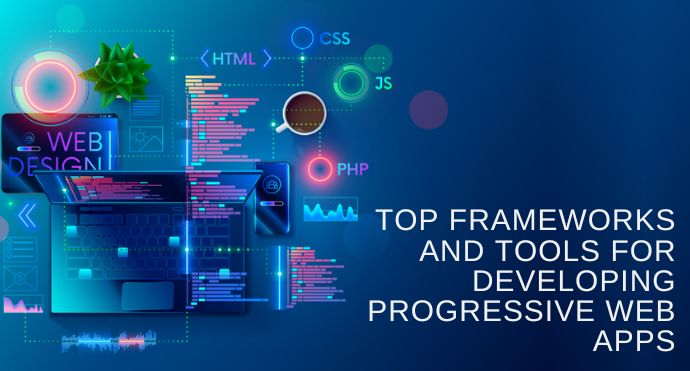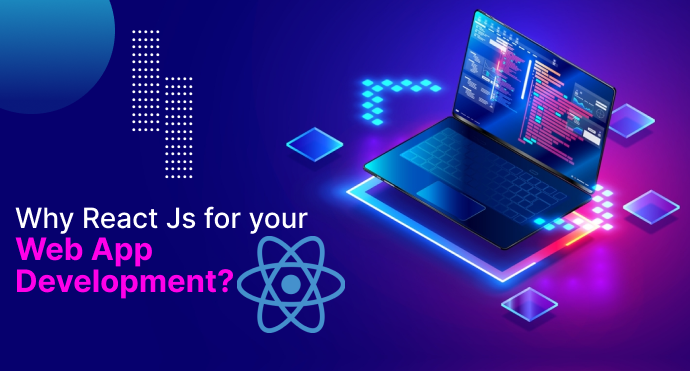Progressive Web Apps (PWAs) are the latest trend in web app development; they offer a variety of benefits, such as improved performance, offline access, and a great user experience. To develop PWAs, developers use a range of frameworks and tools that enable them to create secure, reliable, and fast-performing apps. There are a variety of frameworks and tools available to developers for creating PWAs, such as React, Angular, and Vue.js. In this blog, we will explore the top frameworks and tools for developing PWAs, what each one offers, and how they compare.
React is a popular JavaScript library for building user interfaces and creating interactive web applications. It is a fast, efficient, and flexible framework for developing Progressive Web Apps (PWAs). It supports both front-end and back-end development, making it great for creating single-page apps and multi-page apps. The React framework has a variety of components that can be used to create interactive UI elements such as forms, tables, and navigation. Additionally, React has a wide range of third-party libraries that can be used to add extra features, like animation support and authentication.
Pros
- Fast, efficient, and flexible framework for developing PWAs
- Supports component-based design and creation of interactive UI elements
- Wide range of third-party libraries available.
Cons
- Complexity of the framework can be intimidating for developers
- Not as user-friendly as other frameworks, such as Angular.
Angular is a powerful JavaScript framework developed by Google that enables developers to create mobile, web, and desktop applications. It uses the Model-View-Controller (MVC) architecture, which enables developers to create custom applications. With its component-based architecture and modularity, Angular provides an efficient way to develop PWAs.
Pros:
-React and Angular provide an efficient way to develop progressive web apps.
-Both frameworks provide an extensive library of tools and components to help developers create high-quality PWAs.
-Both React and Angular are highly optimized for page loading times and page loading strategies.
Cons:
-Angular can be difficult to learn and use for beginners.
-React is a JavaScript library, so the complexity of the code can get difficult for larger projects.
-Both frameworks require a lot of time for setup and coding.
Vue.js
Vue Js is a popular open-source JavaScript framework used for developing progressive web apps. It’s one of the most popular frameworks available, and with good reason. Vue Js has a flexible architecture, making it easy to work with, and its intuitive design makes it a pleasure to use. With its comprehensive documentation and expanding library, Vue Js is great for developers of all levels and disciplines.
Pros
– Straightforward and easy to learn.
– Has detailed and comprehensive documentation.
– Provides a powerful and intuitive template system.
– It is well-suited for small-to-medium-sized projects.
– It has an active and supportive community of developers.
Cons
-It is not as well-suited for large-scale projects.
-It does not have as many built-in features as other frameworks.
-It relies heavily on third-party libraries.
-It may require more work in order to write unit tests and perform debugging.
Ionic
Ionic is a popular, open-source framework for developing Progressive Web Apps (PWAs). It provides a set of tools such as components, layouts, and plugins that allow users to create responsive, high-performance PWAs with the help of a single codebase. Its development framework is based on Angular, TypeScript, and modern web technologies.
Pros
- Ionic allows for a fast, reliable, and seamless development process.
- It also makes it easier to create PWAs that cater to both iOS and Android platforms.
- Ionic provides a vast selection of components, libraries, and plugins that developers can use for various use cases.
Cons
- Ionic is not free, and the cost of using it can add up quickly
- The learning curve for developing with Ionic can be a bit steep.
- Some of the components can be buggy and require frequent updates.
PWA Builder
Another popular PWA tool is PWA Builder. It is an easy-to-use tool for creating PWAs from existing web applications. PWA Builder allows you to quickly create a PWA from scratch or from an existing web app using a powerful visual editor. This makes it easy to create PWAs even if you don’t know much about web development.
Pros
– PWAs are fast and reliable, so they provide a better user experience than traditional web apps
– They are flexible and can be used across multiple devices and platforms
– They are cost-effective, making them ideal for businesses on a budget
– They are easy to maintain and update.
Cons
– PWAs are not yet supported by all browsers, so they may not be accessible to all users
– They require more development time than traditional web apps
Polymer
Polymer is one of the top frameworks and tools used for developing Progressive Web Apps (PWA). It provides features like Element library, Polyfills, Web Components, and Fast-Data binding. It enables developers to build high-quality web apps with modern web technologies like HTML, CSS, and JavaScript.
Pros
- It is easy to use, provides a lightweight and modern web design, and is suitable for developing PWAs.
- Its extended support for web components makes it great for building PWAs.
- It also provides fast data binding, which makes data synchronization much easier.
Cons
- Some people find it difficult to understand and use.
- Additionally, it may become slow when used for developing complex PWAs
These are just some of the frameworks and tools available for developing PWAs. Choosing the best ones for your project will depend on your specific needs, but these six are a great place to start.




Your blog article is informative and engaging, offering valuable information in a clear and concise manner. The site’s appealing layout and easy-to-use interface enhance the overall reading experience. Continue the great work!
I just wanted to share my appreciation for the aesthetically pleasing design of your blog. It’s invigorating to come across a website that combines aesthetics with knowledgeable articles. You’ve truly created a great balance!